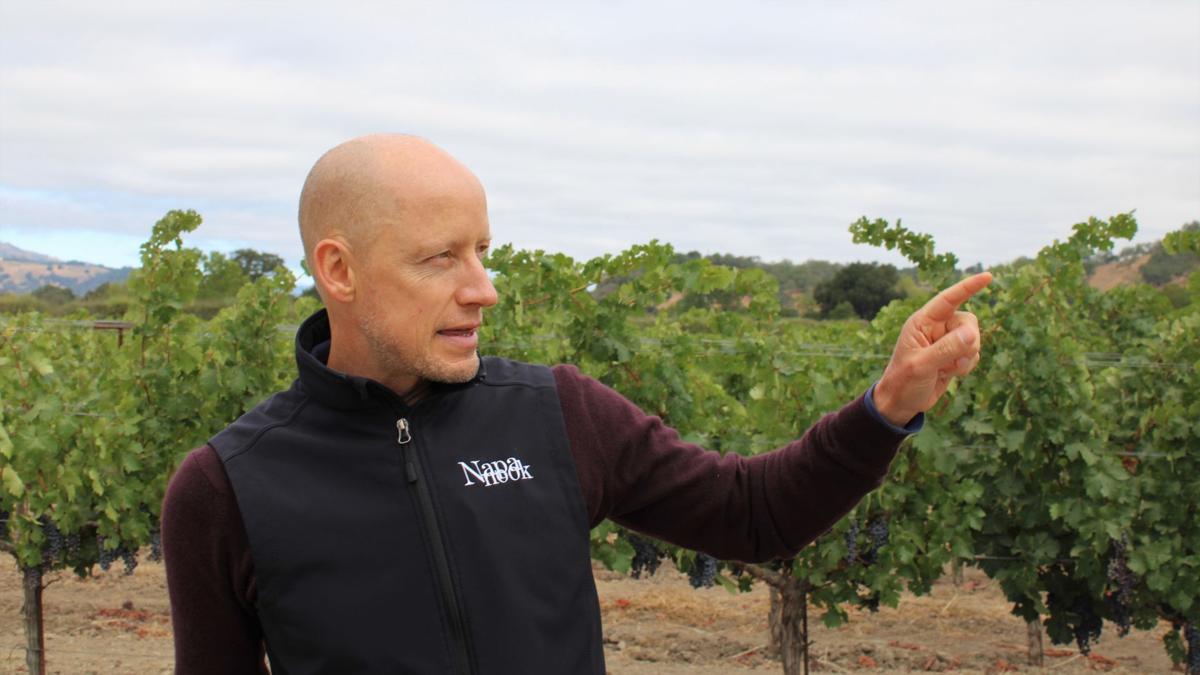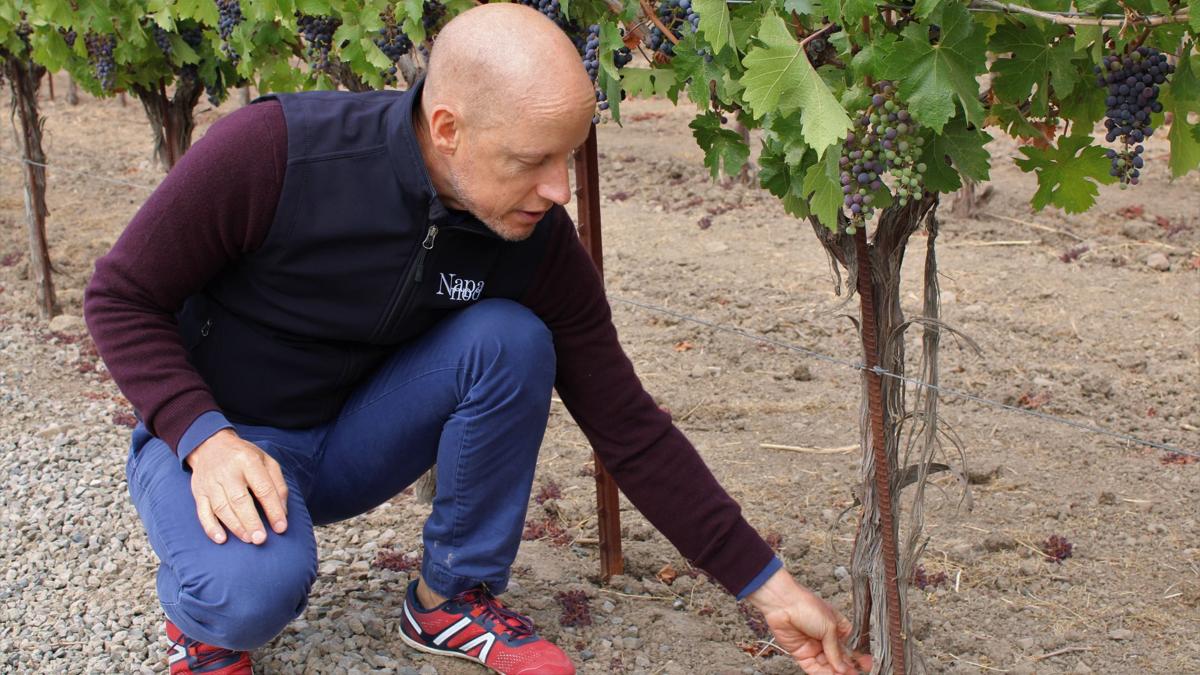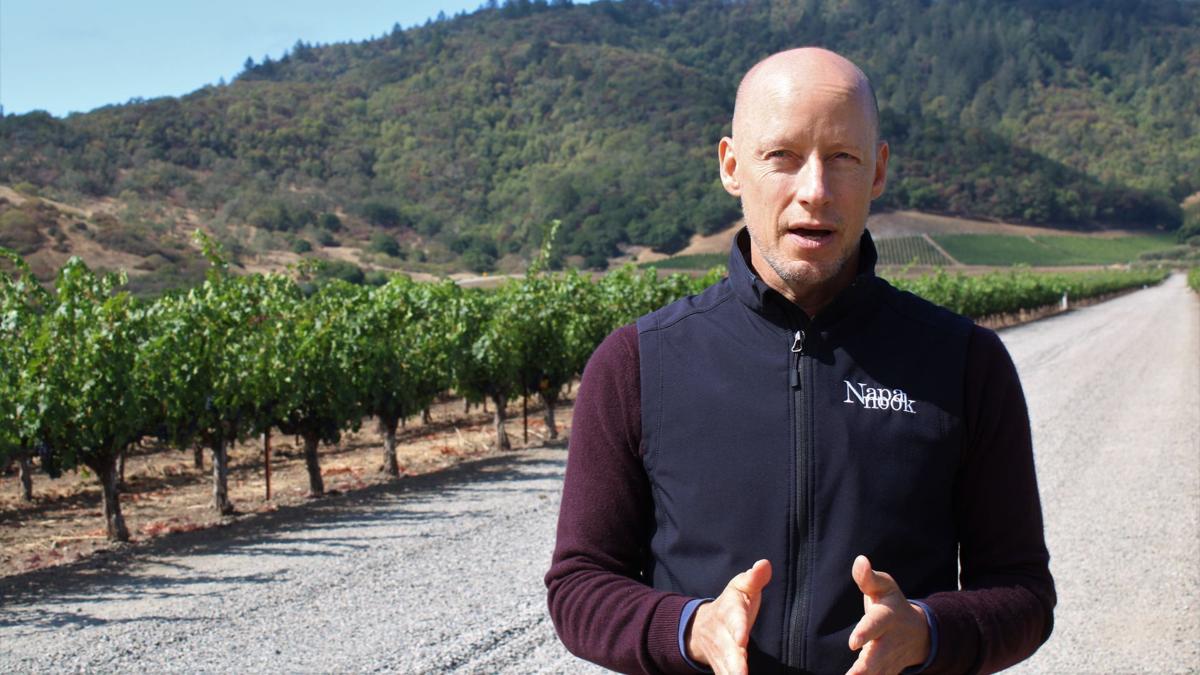For Tod Mostero, Director of Viticulture and Winemaking at Dominus, the jump from architecture to a dry-farmed vineyard wasn’t as far as you might think.
“Architecture is what happens when man meets a place, and he brings his culture, his history, everything he knows, to a place that has conditions of topography and climate, and he has to make a building that works within that environment,” said Mostero. “And same with vines. That is exactly what happened in Napa — the Europeans came with their history, they brought their varieties that they knew, and they had to adapt them to a place that was totally different than where they were coming from.”
Support local news coverage and the people who report it by subscribing to the Napa Valley Register. Special offer: $1 for your first 6 months!
At Dominus’s Yountville vineyard, Mostero is all about priming vines and preparing soils to encourage his plants to adapt to the dry, California climate — all without irrigating.
While this doesn’t mean there is no water use in these vineyards, it does mean that after about four years, the vines no longer need artificial irrigation due to its root depth, location and topography.
“Vines that are dry farmed are better conditioned to deal with drought, but also with disease because of the physiological differences,” said Mostero. “Even though it may seem minimalist, it is actually quite intentional … It’s kind of like a child that you want to be well-trained at something. For our vines to produce effortlessly, it requires a ton of intention and then you intervene at microdoses.”
There are multiple stages of developing a dry farmed vineyard — as Mostero makes it very clear that you cannot retroactively stop an established block from being irrigated — arguably the most important being the actual site being planted.
“Dry farming is proactive, meaning it's not just turning off the faucet and saying I'm no longer applying water … It requires a certain number of practices in order to optimize the amount of water available to the vines,” he said.
Dominus’s Napanook vineyard has a rich history in grape growing, and according to Mostero, the land has been used as such for almost 200 years.
“This was the first ranch planted in Napa in 1838 that was planted by George Yount, and that’s important because he inherited more than 11,000 acres in this area,” said Mostero. “He decided to plant here, and there's a reason.”
Nestled up against a series of hills, the Dominus vineyard sits closer to the base of the valley, atop a geographical formation called an alluvial fan. Mostero said that over 15-30,000 years ago, the hillside had a different form, with rivers and melting ice running down the side. The rivers then dragged various materials — rock, gravel, sand, silt, clay — with the heaviest particles settling at the apex of the fan. Below this is a natural hardpan, which is a dense layer below the topsoil.
“But the most important water for us during the summer is the water that falls on the mountain, because that is a huge reservoir of water — like a sponge — and throughout summer, after it stops raining, that percolates down throughout the mountain, and it hits that hard pan and it flows toward the center of the valley,” said Mostero. “All around Napa we have these alluvial fans, and that's where the original vines were planted, and it made sense because they didn’t have irrigation.”
The Soil Prep
The next step in establishing a dry farmed vineyard comes with preparing the site and its soil.
Mostero says you can't have artificial hard pans — meaning compacted, dense layers created with machines or tractors — because the vines need to have deeper roots than typically necessary. He explained that below the ground at this site, due to the mountain pushing its collected water down and through the valley, actually has an abundance of water, the vines simply need to be able to reach it. In fact, he actually prefers a dry spring.
“Because of our dry summer climate, if the vine keeps pumping in May, June, July, by the time it gets to August, it's pumped a lot of water out of the soil,” said Mostero. “It's not conserving that water, but it hasn’t rained, so at the end of the season because of the leaf surface area, the transpiration is going to be high, and the amount of water in the soil is going to be low, so the vines have a tendency to crash.”
To keep the vines from crashing, Mostero and his crew do everything in their power to manage how the roots are growing and how much pressure they experience at different times of the season. He says there is a vessel that connects from the roots to any given leaf, and through the process of photosynthesis, may create a vapor pressure deficit depending on how tight or large the vessel is.
If the vessel is tight, it's able to more effectively and more powerfully pump water. But if the vessel is large, it doesn’t pump as efficiently.
“When you dry farm, the vine naturally produces small vessels, which translates into very hard wood like an oak tree, as opposed to irrigating a lot, which produces very large vessels and spongy tissue, which is more susceptible to embolisms, or what we call cavitation,” said Mostero. “By dry farming, you’ve actually changed the physiology of your vine.”
Upon planting the root stalk, the Dominus team lets the plant grow very bushy with the mentality that the amount of vegetation produced by a plant mirrors the degree of development of the root system.
“When you let a plant grow very bushy, it’s able to produce a lot of photosynthesis and it will be hearty,” said Mostero. “And then we can better help the vine adapt to a dry farm situation.”
About three or four gallons will be used to irrigate that stalk in its first year, with the following two years relying on a biannual spritz from a drip irrigation line.
“After that, year four, which is the first tear that the vine really starts to produce, we are dry farmed and we no longer add water,” said Mostero. “The vines have established themselves, — they haven’t gotten to the full root depth — but we consider that a vine can get through at that stage.”
The upkeep
After planting, even after irrigation has ceased, the work is nowhere near over for the Dominus vineyard staff. The stalks are grafted in year two, and then they use a tool called a ripper between the rows to cut any superficial horizontal roots. When needed, they also may bring in a French plow to weave between the plants to remove the cover crop and superficial roots.
“Another important tool is the use of certain equipment to cultivate, and you hear a lot of talk about no till versus till; that till is bad and no-till is good, but we believe it’s more subtle than that and it should be nuanced,” said Mostero. “What happens when you scratch the surface is that you actually are creating a soil mulch that when the moisture comes up, it hits that mulch and it can’t go anywhere.”
After (and during) this hands-on maintenance, Mostero says they are basically working to optimize the amount of water available to the plant through a couple of things, number one being cover crop.
“Cover crop is necessary in Napa in the winter to absorb any excess rain and to avoid erosion,” he said. “You don’t want water to be running off and pulling with it all of the soil, and cover crops can be used to absorb more or less water according to the needs of the plant.”
Dominus plants cover crops that can adjust nitrogen levels without competing with the vines, such as legumes, beans and peas, in addition to wildflowers in the estate’s borders, islands, and corridors. Typically, this includes California golden poppies, bluebells and purple Chinese houses.
“All of those will attract pollinators, which have a tendency to feed on or prey upon the pests of the vineyard, so that's very beneficial,” said Mostero. “We’ll have anywhere from 15 to 20 different species that will use our cover crop, so it helps to increase biodiversity, and the biodiversity above ground is mirroring the biodiversity underground.”
So, why dry farm?
This mirroring effect is integral to the mission of Dominus and Mostero’s team, as they are constantly trying to capture the essence of their estate in their wines. In having these ultra-deep roots, the grapes — and thus wine — are saturated in its unique composition of minerals, rocks and soils, with these deep flavors represented in the end-product.
“Balanced wines need balanced vines,” said Mostero. “If a root never goes into those areas, you don’t get to explore the difference that gives you, so you could never tell that story in your wine.”
This storytelling nature of wine is what initially brought Mostero to the industry, after all, saying that when he tasted his first “real wine,” he realized that the drink is supposed to translate a place into a liquid. He had studied architecture in New Orleans and had seen how buildings could pull off this sort of magic but didn’t know the same phenomena was possible with agriculture.
“The wine had a personality and it had a soul, and everything connected at that moment that I realized there was this thing called winemaking that allowed you to work with nature, to harness the elements and produce this thing that was an expression of place,” he said. “That is what I tasted when I had my epiphany.”
Recycled water is becoming a hot commodity amid the drought. Here's where it all starts.
You can reach Sam Jones at 707-256-2221 and sjones@napanews.com.
"do it" - Google News
August 10, 2021 at 06:19AM
https://ift.tt/3iwsIrI
Dry farming a vineyard: What it is, how to do it and why it exists - Napa Valley Register
"do it" - Google News
https://ift.tt/2zLpFrJ
https://ift.tt/3feNbO7
Bagikan Berita Ini

















0 Response to "Dry farming a vineyard: What it is, how to do it and why it exists - Napa Valley Register"
Post a Comment